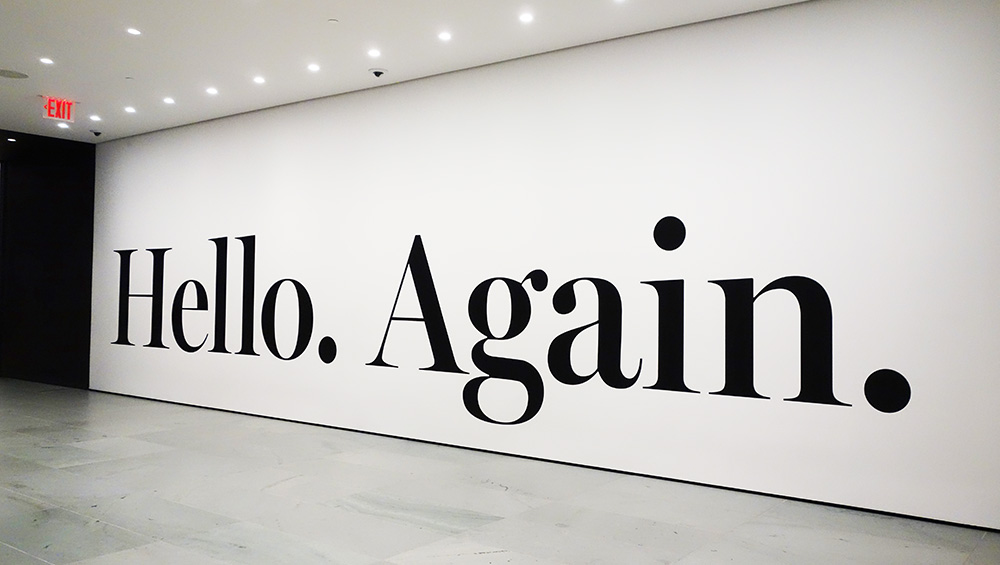
Haim Steinbach, hello again, 2013. Photo: Antonio Rivera.
by JILL SPALDING
With a long line but no fanfare, the Museum of Modern Art has reopened for business after a months-long closure that left New York on withdrawal. The motivator – more space – had been widely seen as self-serving. A sixth expansion? Only vanity could explain it! Conveniently forgotten was the amount of art piling up from ignoring the founders’ resolve to unload everything that had aged out of contemporary. More tolerated was the stated mission: to “rethink” what defines art and “re-energise” its presentation. Still, patrons asked, why could not both have been realised with the so recently revamped Taniguchi iteration?
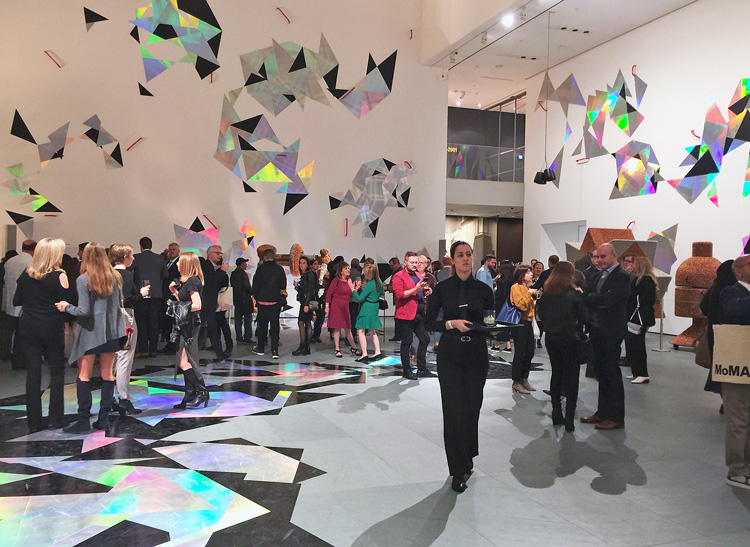
Reopening party, MoMA, New York, 2019. Photo: Jill Spalding.
We found out on 21 October 2019, a watershed date every bit as significant as the 1929 breakout opening of MoMA’s first iteration. The question then was what is modern art? The answer, bounced off the notorious 1913 Armory Show, which saw Henri Matisse’s work burned in effigy and Marcel Duchamp’s Nude Descending a Staircase proclaimed “scandalous”, was Matisse, Duchamp and every white and male iconoclast modernist between. A bold vision to be sure, but confined to a club of European artists which, with a small nod to Iranian and Mexican art, remained closed to outsiders. There followed MoMA’s disruptive abstract expressionism explosion that skewed the definition of art to non-representational and its throne to the US. A few women made the cut, but the manifesto was male. “The large windows between the paintings interested me more than the art,” Ellsworth Kelly noted of the Paris Museum of Modern Art. “From then on, painting as I had known it was finished for me.” There were brave firsts: in 1932, the inclusion of architecture; in 1934, industrial design; in 1937, photography; in 1995 video; and, in 1999, the first-ever exhibition installed thematically rather than chronologically. The merge with PS1 in 2000 enabled fabricated outdoor architectural environments, and subsequent exhibitions and acquisitions added art assembled from edible and friable materials.
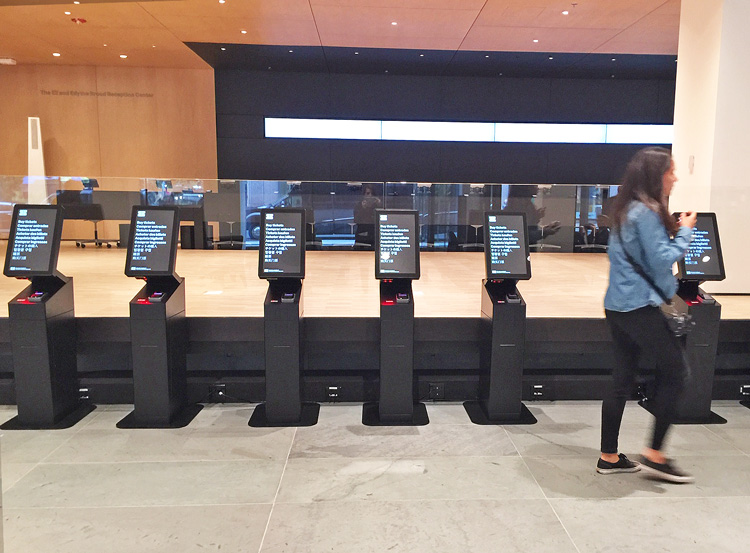
Ticket machines at the entrance of MoMA, New York, 2019. Photo: Jill Spalding.
The curatorial push forward, however, proved not nimble enough, given how long it took for the hallowed western canon to be questioned; indeed, even addressed. Moot was diversity – work by women artists, black artists and the ever-widening diaspora of artists working across spreading boundaries. Globally, the visual, aural and performance arts had been weaponised to explode and reshape the old order. The world had moved on and MoMA was trailing.
No more. A rash of gifts began pouring in, matched by as many purchases as funding allowed, all begging the suddenly urgent question, how and where to exhibit them? The answer, this new addition makes clear, is a bold vision, newly established curatorships and 47,000 square feet of extra show space.
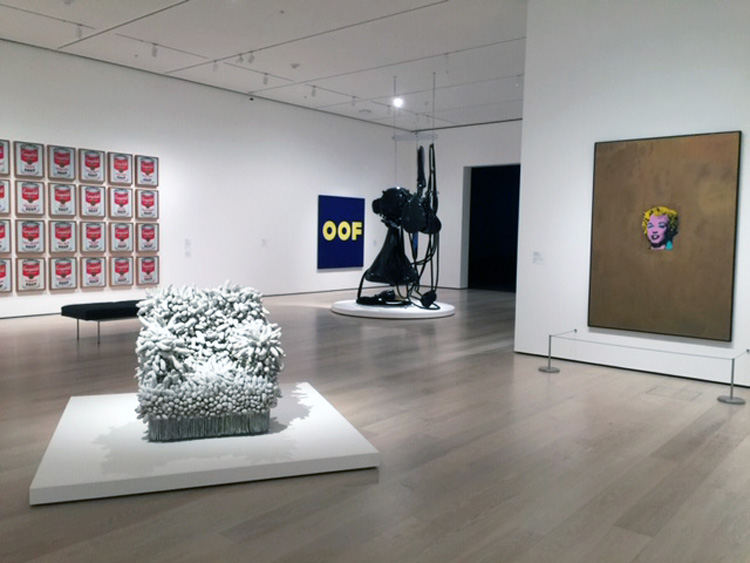
Installation view, MoMA, New York, 2019. Photo: Jill Spalding.
“It’s very chic,” I overheard, going in. Not wrong, if confined to the initial sense of muted palette and quality materials. Showing every penny of the $450m poured into it, the Diller Scofidio + Renfro addition to the restored Taniguchi building is seamless, and that bete noire of crowd control (now termed “flow”) has been achieved with a glamorous new staircase and a bold reordering of the space opened up by moving the store.
The only doubt facing first-timers is whether to head straight for the new floors, because the logic of its physical structure is not immediately clear. Only proficient map-readers will benefit from the one given out and with little more direction from the guards than “turn west and keep going” you might, as I did, experience a sort of reverse phantom-limb syndrome. Beginning on the ground floor, you enter slick spaces that you know weren’t there before, yet seem familiar. The same cool materials and sharp angles, the same tasteful beige and white. The only indication that you are not walking into a mirror-image of the old building is a sliding door framed in black steel. This – like the mild vertigo experienced looking down to the street from the rear windows – with repeat visits will pass.
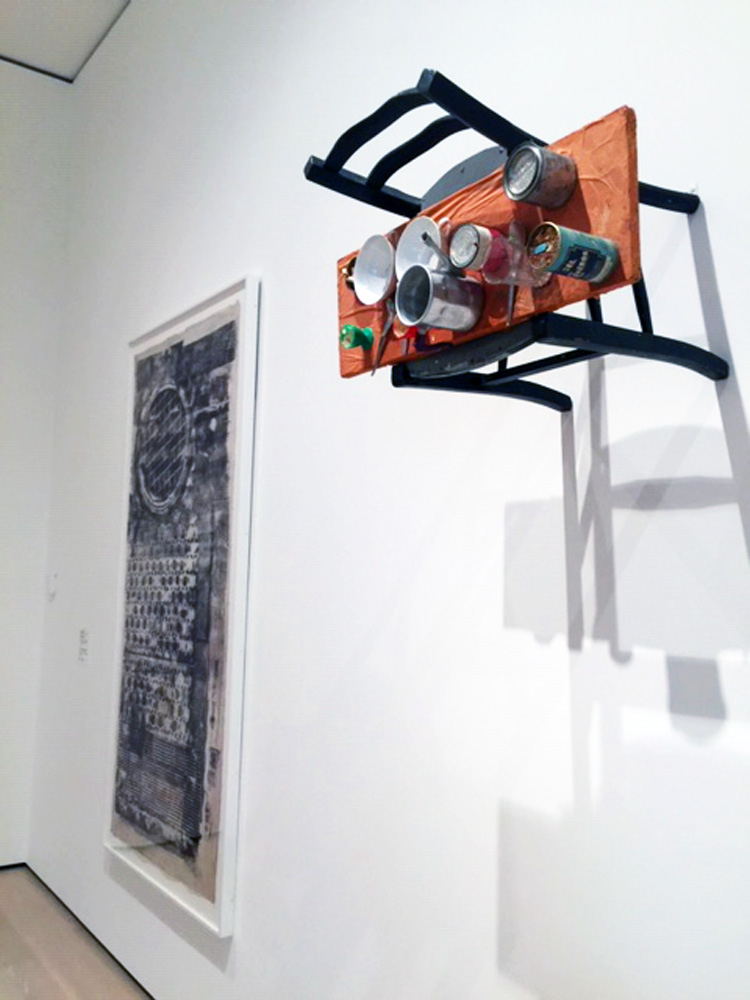
Daniel Spoerri. Kichka's Breakfast I, 1960. Photo: Jill Spalding.
Meanwhile, welcome the confusion. Intended or not, losing one’s bearings serves the new mission well. As with a Dana Schutz painting, your first impression is sublime order imposed on an earthquake. The spaces are wide, but rife with intervention. Work jumps off a wall (Daniel Spoerri), pierces the ceiling (Sheila Hicks), hugs the floor (Lynda Benglis). Glance down at your mobile phone and you might brush the Lee Bontecou, scuff the Mark Manders, graze the Robert Gober, trip over the Roni Horn, step on the Ana Mendieta, or back into the David Smith. Each work has a wall label, but some labels have no art, until you look up to find it high above you. And so likely are you to stumble inside Hito Steyerl’s jagged installation Liquidity Inc that it is signposted “Proceed With Care”.
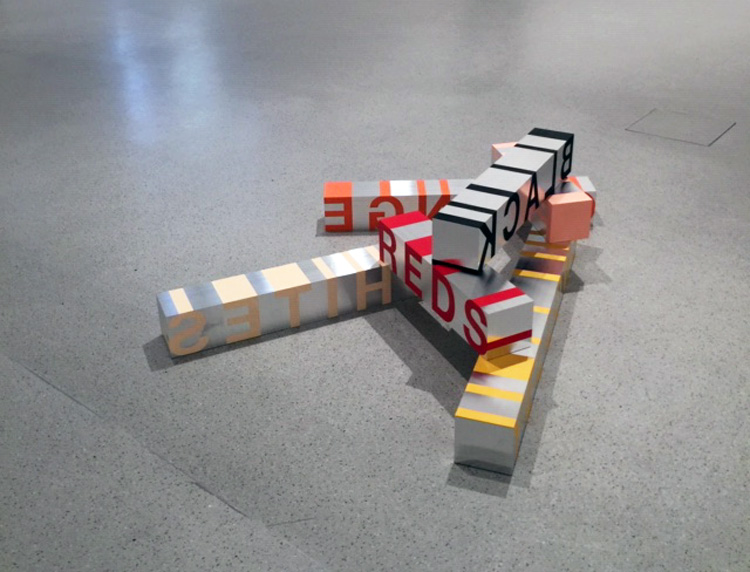
Roni Horn. Stevens' Bouquet, 1991. Photo: Jill Spalding.
There is a logic, nonetheless. As before, there are five full floors for art, three profiling the museum’s collection (through to 1940 on the fifth; to 1970 on the fourth; to today on the second). Start with the modernist icons to recover your balance. Grand to see, as for the first time, Van Gogh’s The Starry Night and Paul Cézanne’s The Bather – both freed from layers of varnish. Reassuring to find Frank Stella’s stated two sides of the 20th-century-art coin (Picasso-Matisse-Miró/Kandinsky-Mondrian-Malevich) still front and centre – though Stella himself now shares a wall with donor-names “Geffen” and “Kravis”. Don’t look, though, for the same chronological lineup. Claude Monet’s Water Lilies, Picasso’s Horta de San Joan, Summer, Ernst Ludwig Kirchner’s Street Dresden and Jackson Pollock’s One: Number 31 still announce impressionism, cubism, surrealism, expressionism and abstract expressionism, but, reflecting the new understanding that there is no single or complete history of art, many are installed out of their comfort zone to jettison preconceptions.
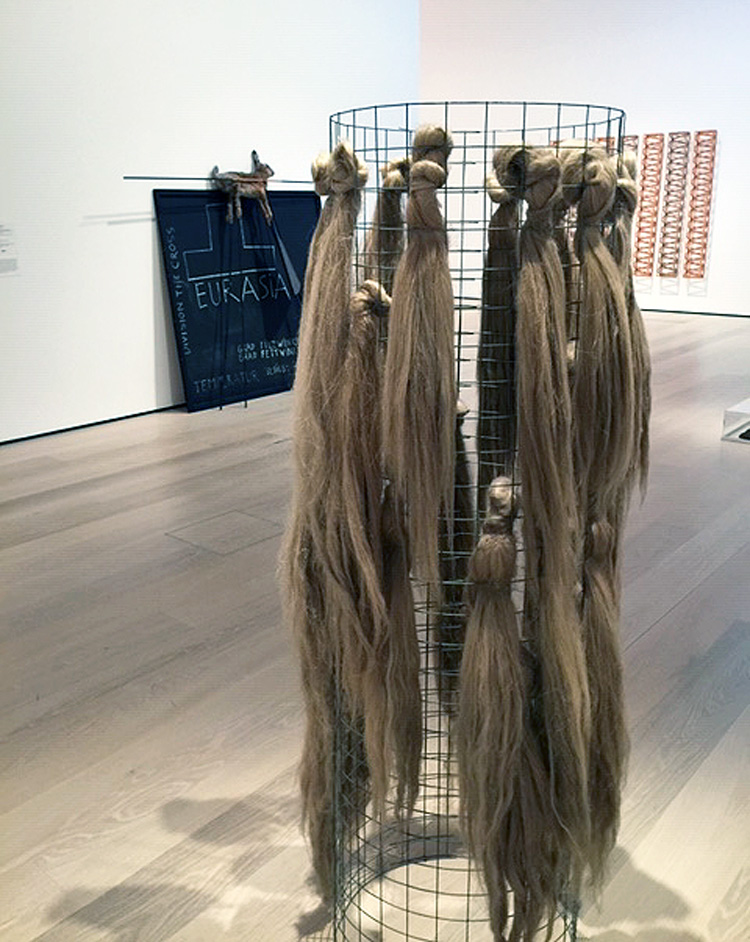
Marisa Merz. Untitled, 1966, with Joseph Beuys, Eurasia Siberian Symphony 1963, 1966 in the background. Photo: Jill Spalding.
The deft rehanging draws on profound scholarship for startling juxtapositions that create new conversations: there is a witty dialogue between a Marisa Merz wired hair-like sculpture and a Joseph Beuys stuffed hare; glimpsing Picasso’s Bather through Louise Bourgeois’ Quarantania 1 conflates two takes on female sexuality; paired with African-American Faith Ringgold’s Guernica-inflected America People Series #20: Die (1967), Picasso’s Les Demoiselles D’Avignon (1907) radiates female and black power; Maya Deren’s dancing video activates the rhythm in Wifredo Lam’s adjacent painted The Jungle.
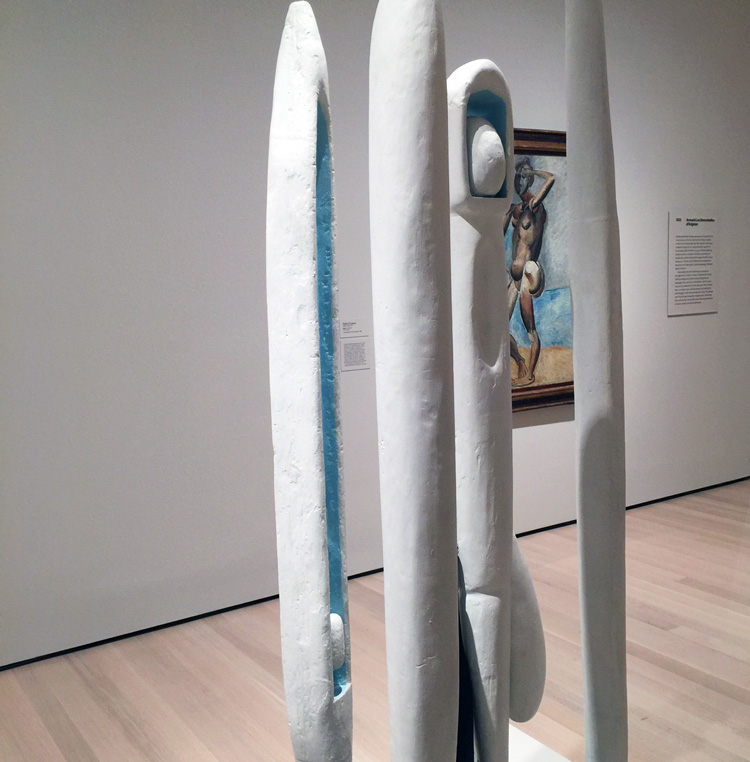
Louise Bourgeois. Quarantania, I. 1947-53 (detail). Reassembled by the artist 1981. Photo: Jill Spalding.
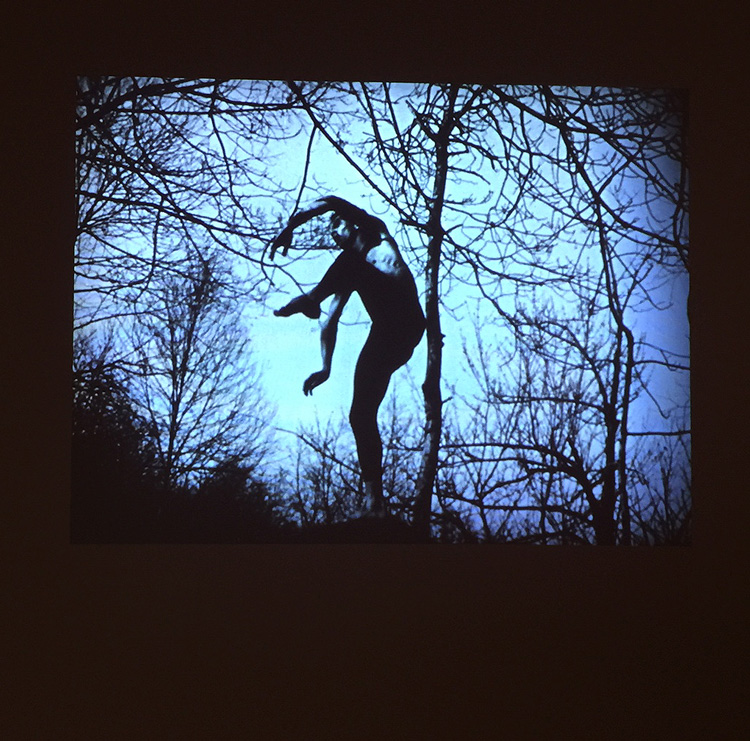
Maya Deren. A Study in Choreography for Camera, 1945. Film, 3 min. Photo: Jill Spalding.
Much, though, as elsewhere, is up to you. Why, for example, is a vitrine full of the long-neglected American ceramicist George Ohr’s collapsed vessels facing French painter Henri Rousseau’s The Sleeping Gypsy? Again, I suspect, the idea is to mess with your expectations.
Moving through, you may feel temporarily unmoored; the galleries are numbered, but not always sequentially (406, for instance, adjoins 415, which segues to 418) so if you lose track, you might circle an installation and exit where you entered. Fear not; each room is self-sufficient and organised around a topic (“theme” so passé) – a time, place, concept, or practice closely detailed in a wall-text. Self-explanatory are Action Painting I and II, but pause to reflect on pairings that join famous names (Helen Frankenthaler and Joan Mitchell) to neglected ones (Grace Hartigan). Downtown New York looks at the postwar scene’s frothy interaction of artists and movements, profiled in depth by Cindy Sherman’s Untitled Film series.
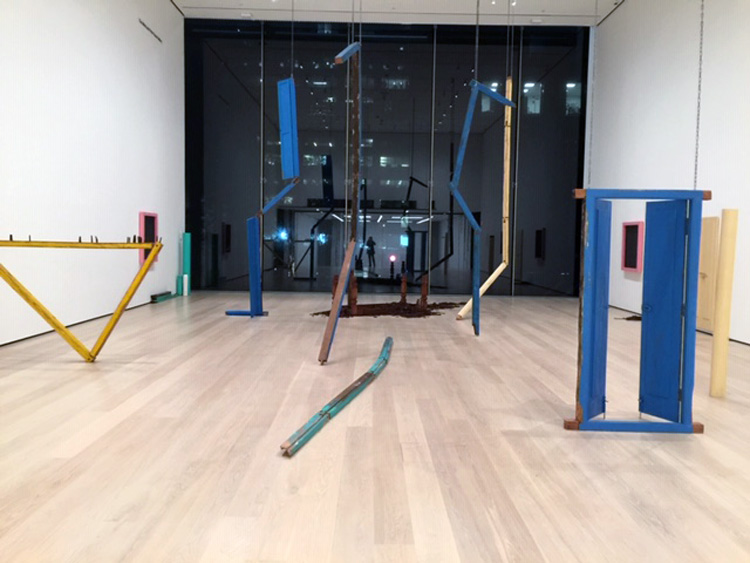
Sheela Gowda. Of All People. Installation view, MoMA, New York, 2019. Photo: Jill Spalding.
There is a wide look at assemblage, leading off with Sheela Gowda’s elaborate second-floor installation of elements rescued from Bangalore’s gentrifying communities to create phantom memories. Heading up to the sixth floor, Surrounds comprises 11 installations including the world in flux that Sarah Sze fashioned from a flotsam of found materials so fragile as to warrant “do not touch” signs. Other standout installations are Dayanita Singh’s provocative screen-folding photo-architecture, and Amy Sillman’s inspired Artist’s Choice, The Shape of Shape, selected from the museum’s permanent collection to reanimate the forms she plays off each other.
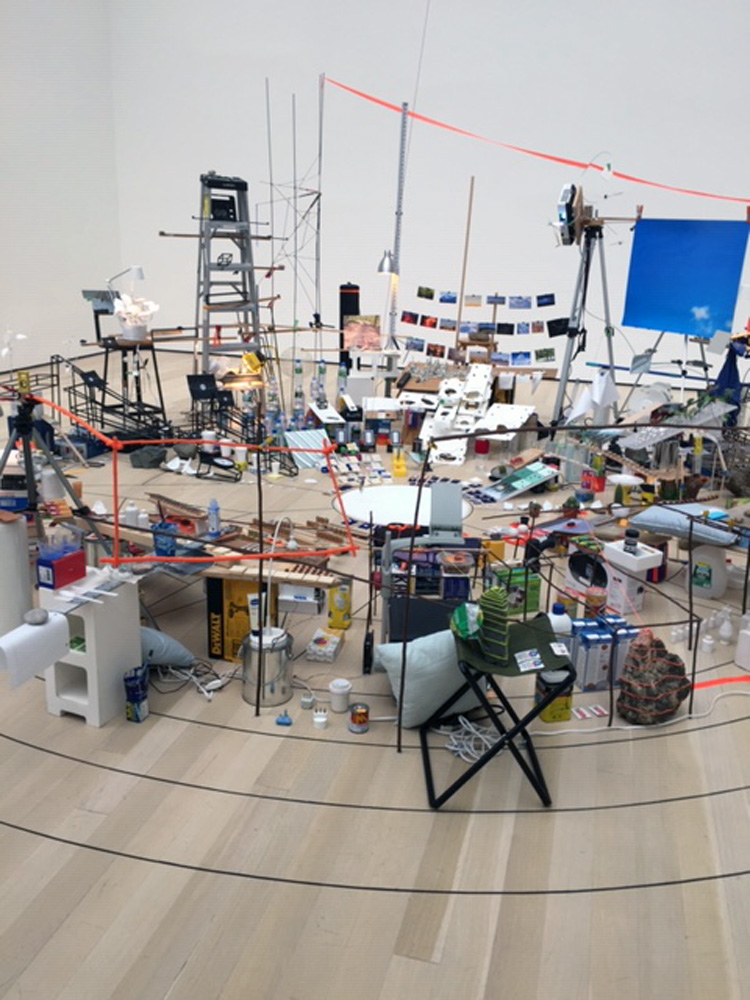
Sarah Sze. Triple Point (Pendulum), 2013. Photo: Jill Spalding.
Close attention is given to performance; hourly, two boy sopranos lament the Allora & Calzadilla felled monuments; and daily at 4pm in the atrium, the six bell-shimmered wheeled sculptures in South Korean artist Haegue Yang’s elaborate Handles installation are creatively repositioned.
Ample space is given over to architectural practice – through drawings (Frank Lloyd Wright’s utopia); models (Álvaro Siza’s social housing project); assemblage (Sou Fujimoto’s query “Is a potato chip architecture?” answered here with a cluster of miniature of architectural elements as modelled by a ping pong ball, a sponge, a paper clip and, yes, a potato chip); and heroic installation (an actual section of the UN’s original glass window views on a looping metropolis in Jacques Tati’s Playtime). Notable, too, the pervasive conversations between sight and sound – every floor throbs with the buzz, beep and hum of a nearby video or installation – even the new sliding doors woosh.
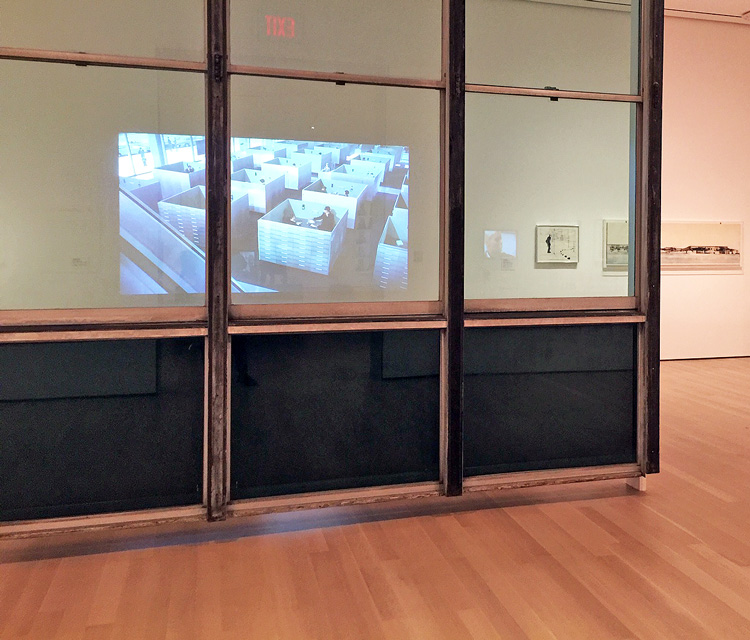
Jacques Tati. Excerpt from Playtime, 1967, viewed through the glass facade from the United Nations Secretariat Building, New York, 1952. Photo: Jill Spalding.
The “isms” doctrine is history, replaced here with more open ideas. Art as concept frontlines Rivane Neuenschwander’s stand-in for death Work of Days installation lined with transparent sheets of adhesive plastic to catch dust. Art as visual language letters thought with Haim Steinbach’s welcoming Hello Again, Ed Ruscha’s brazen OOF and the the high irony of William Copley’s Untitled (Think / Flag) (1967). Speaking to curatorial versatility, a gallery given over to survival addresses environmental concerns with work ranging from Philip Guston’s apocalypse to Marisol’s ravaged-body to Tetsumi Kudo’s poisoned wildflowers. More subtly, a kind of tic tac toe through floors and along galleries stimulates connect-the-dot reflections on the nude body, on gayness, on colour, conflating a Wilhelm Lehmbruck with a Berenice Abbott, a Lyubov Popova with a Carmen Herrera, a Herbert Bayer with a Hans Bellmer, and Kandinsky’s vibrant palette with that of Tarsila do Amaral and Georgia O’Keeffe.
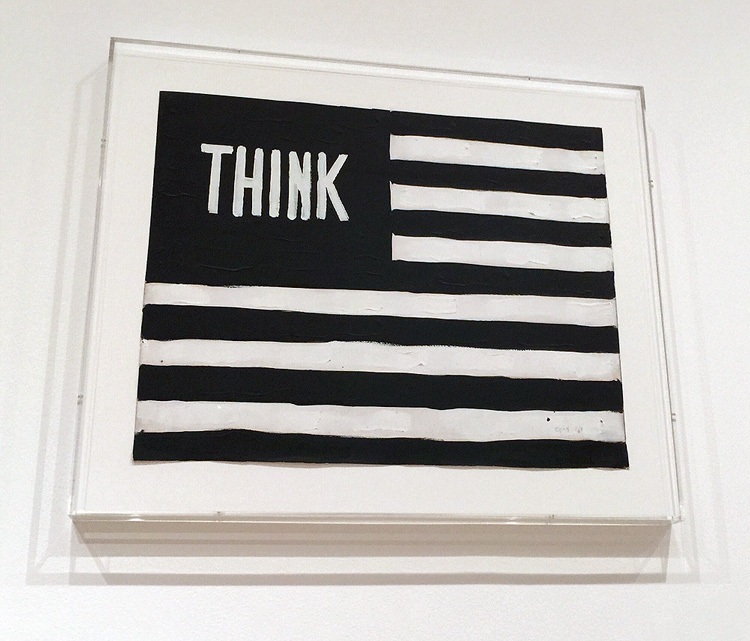
William Copley. Untitled (Think / Flag), 1967. Installation view, MoMA, New York, 2019. Photo: Jill Spalding.
As brilliantly stimulating, if more complex to parse, are galleries given over to practice that flips the question “How do you see?” to “How do artists see?” with works addressing identity (photographer Catherine Opie’s Dyke 1993); protest (Hérvé Telémaque’s painterly, racially charged The Ugly American); and upheaval (Zarina’s 36 lyrical woodcuts recalling her lost home in India).
Loosely grouped under rubrics that will presumably umbrella works rotated in are deep dives into process and the visions that widened art’s boundaries. Discovery addresses spatial ideas like the grid with work by Russian constructivist Aleksandr Rodchenko paired with newly acquired Latin American artists. At the Border of Life and Art opens on the Fluxus moment with a once-revolutionary red-flamed combustion of Stop/End “event scores” promoting the basic actions and materials of a “Non-Art Reality”. Transfigurations groups work by women across cultures and generations past and present who plumbed myth and folklore to reimagine the female form (Jo Baer). Print, Fold, Send exhibits art as ephemera – postcards, flyers, posters, ’zines – scribbled, drawn and distributed by mail, small presses or nascent video, the León Ferrari composite a standout. Addressing violence, War Within War Without confronts the horror inflicted on Vietnam, while Before and After Tiananmen reveals the evolving techniques artists used to confront and defy. More obliquely, Inner Outer Space asks what constitutes a border – lines drawn between nations? People? Past and present? – with Che Zhen’s wood chair-and-candles wall sculptures (Un Village San Frontières) and Zarina’s finely drawn Home is a Foreign Place. Worlds to Come examines art of the last decade that replaced tidy pronouncements with work pulled from the black holes of trauma to reimagine a more hopeful future.
And everywhere, the urgent revision. Three temporary solo shows, archival holdings and strong acquisitions render blackness explicitly visible; Betye Saar: The Legends of Black Girl’s Window; member: Pope.L, 1978-2001, the storied Jacob Lawrence Migration Series; eight culture-subverting paintings by Michael Armitage, James Kerry Marshall’s commanding Untitled (policeman) 2015, and a vibrant installation of film and photographs taken in and around Harlem.
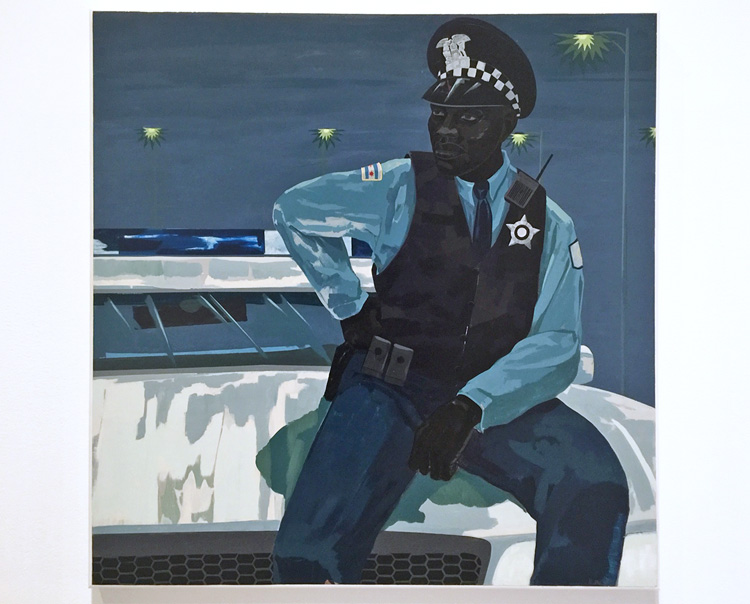
James Kerry Marshall. Untitled (policeman), 2015. Acrylic on PVC panel with plexiglass frame, 60 × 60 in (152.4 x 152.4 cm). Installation view, MoMA, New York, 2019. Photo: Jill Spalding.
Latin American art from Brazil, Venezuela, Uruguay and Argentina, jumpstarted by the donated game-changing Patricia Phelps de Cisneros collection, is now displayed on all floors and explored in depth with Sur moderno.
And across galleries and disciplines find dynamic narratives pioneered by women (Anni Albers, Ana Mendieta, Barbara Kruger, Dara Birnbaum, Isa Genzken, Jenny Holzer, Zarina, Anna Atkins, Mrinalini Mukherjee, Amanda Williams, Sadie Benning and Julie Mehretu among those following on from archival material that brings lesser-known late-19th century female artists such as Gertrude Käsebier and Mary Beth Edelson to the fore), up from an estimated 5% of the collection in the 2004 Taniguchi installation to a more respectable, if still wanting, 28% here.
There is plentiful video material – pause before Cecilia Vicuña’s What Is Poetry to You? (1980) and the Joan Jonas immersive video installation Mirage, which revisits a 1976 performance that used drawing and props to enact rituals of transition, and Jodi’s My%Desktop (2000), which recreates a stunning sequence of the artists’ jumpy, computer-generated, browser-based interactions performed for live audiences.
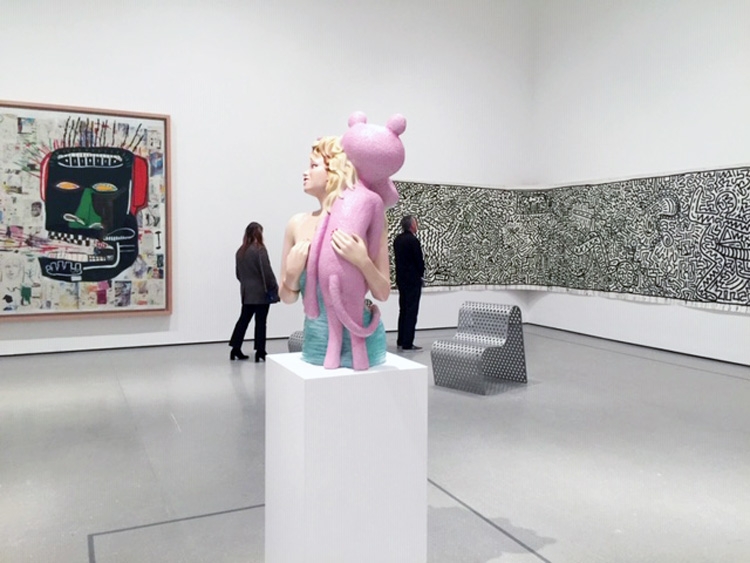
Jean-Michel Basquiat, Glenn, 1985; Jeff Koons. Pink Panther; 1988; Keith Haring. Untitled, 1982. Photo: Jill Spalding.
.jpg)
Left: Jackson Pollock. Echo: Number 25, 1951, 1951; Right: Lee Krasner. Gaea, 1966. Photo: Jill Spalding.
There are nods to sheer beauty (Yves Klein’s trademarked sky-autographed saturated ultramarine and Hilma af Klint’s glowing orb) and endless moments of curatorial genius; the adjacent verticals of Isamu Noguchi’s columned centipede and a columned window, a side-walled Jackson Pollock deferring to a wall-long Lee Krasner; an off-kilter composite of unsettling Wolfgang Tillmans material; a Dan Flavin placed to illuminate a radical shift of perception; a cheeky Jeff Koons faced on a defiant Jean-Michel Basquiat. There is attention to overload with a small palate-cleanser interlude cushioned by seating at small tables, which reflects on a moment – currently, the marking circle and times of American poet Frank O’Hara.
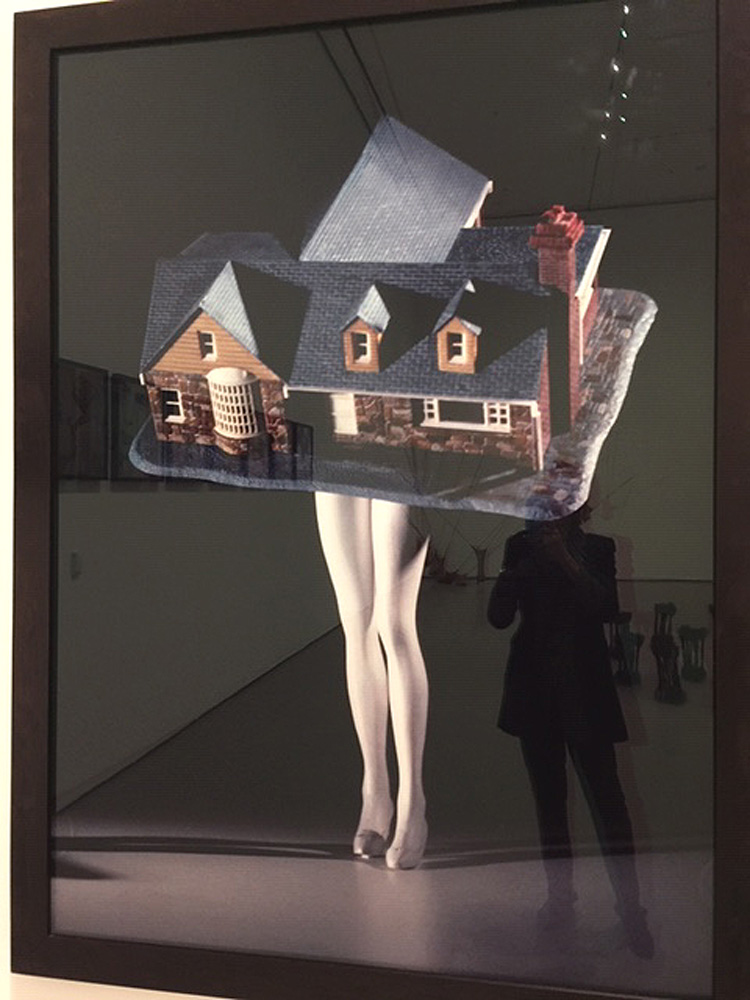
Laurie Simmons. Walking House, 1989. Photo: Jill Spalding.
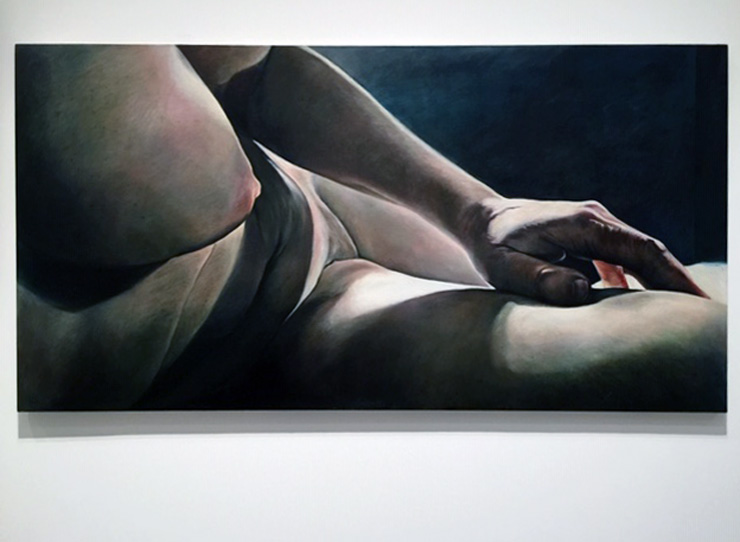
Joan Semmel. Night Light, 1978. Oil on canvas. Photo: Jill Spalding.
There are plentiful teaching moments, such as pairing Laurie Simmons with Joan Semmel, and Xu Bing’s subtle regime-protesting agrarian woodcuts with Huang Yong Ping’s overtly condemning colonialist Palanquin. And full advantage has been taken of the new addition’s vaulting spaces; don’t miss David Tudor’s immersive polyphonic sound-sculpture installation Rainforest V (Variation I), realised by the artists of Composers Inside Electronics, and the – be still my heart – glorious flock of Brancusis, now ranging free.
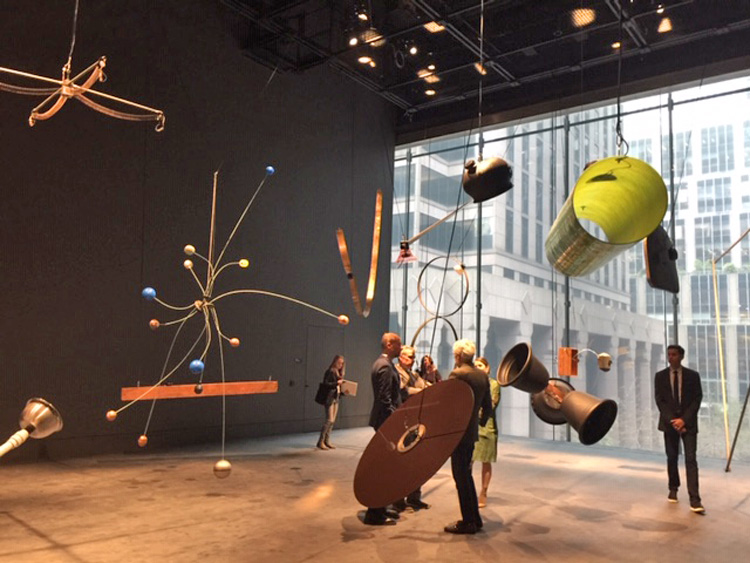
David Tudor and Composers, Inside Electronics Inc. Rainforest V (variation 1). Photo: Jill Spalding.
There is more, much more; find outsider art, ready-mades and five impressive commissioned installations, several to locate. There is a wall showing reels of home movies on deteriorating nitrate film, multiple galleries given over to design, a show of textiles, a section devoted to Russian books.
Inasmuch as the Metropolitan Museum of Art is less a building than a city, so, too, now is MoMA. Reworked space and new facilities expand the institution’s educational outreach and anchor the institution’s leading role in art conservation and research. You can spend the day here. Watch a vintage movie; meditate in the sculpture garden; lunch on the sixth floor with a marbled artwork by Kerstin Brätsch in the new floodlit sixth floor Terrace Cafe. The structure itself, with the minor caveat of two awkward columns, is an unqualified success. Grand that the fortressed facade has been opened to street viewing! Gladdening that an airy stairway now lets you bypass the slow lifts and narrow escalators, and a shout-out for the tech-savvy restrooms!
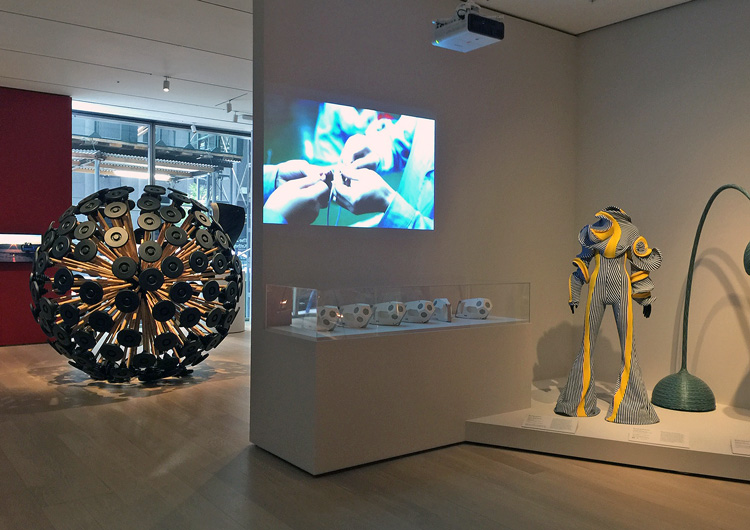
Installation view, MoMA, New York, 2019. Photo: Jill Spalding.
The new MoMA’s triumph, however, lies elsewhere. More obvious to artists than to patrons is that museum infrastructure (pace the Guggenheim) serves mainly to stage art. Kudos to the Diller Scofidio + Renfro/Gensler team for the clean frame, tech-savvy materials and adaptable spaces, but their topping success is to have made way for the content. The dreaded expansion has opened an airy sandbox for curators to play with material drawn from among the permanent collection’s 200,000 artworks so as to put on display every identifier and idea that constitutes the newly flexible idea of what defines modern art.
Double kudos to the curatorship – here is art-making viewed across disciplines; art bisected, dissected and in the round. Artist input was only “here and there”, said chief curator Ann Temkin, “basically how to position the sculpture” – and yet, led by Odilon Redon’s Eye-Balloon, the artist’s eye pervades all. Indeed, I hold that this effort’s overriding success has been to return art to the artists. Every existing technique, process, material and visual language is on view for them – a modern-day studiolo magnified for their expanded needs.
Explore this new MoMA as laboratory, academy, repository, showcase and, above all – in the sum of its parts – as an avant-garde artwork. Visionary in that the museum is now sighted for artists as much as for us, and nimble in that (excepting the modernist icons, I presume) a third of the collection will rotate out every six months, so that every 18 months, as with a body shedding cells, none of the original installation will remain on view. If the opening presentation is not to your liking, if you are missing some favourites, if you were hoping for more this or less that, the subliminal curatorial message is: “Stay tuned.”
Gone is modernism as monolith. Gone, rigid timelines. Gone, even a hint of the high/low distinction between popular culture and art. Vanished, too, even in the lineup of icons, is any sense of art as an asset class, trophies collected to put into storage and flip for a profit. Unlike MoMA’s debut, there is no overall manifesto, no single vision. Rather, a vibe and a promise. Going forward, new art will no longer be a mannerism, or a school, or even a movement, but rather an evolving experience of a world that is ever in flux. Come to see, to learn and, most urgently, to feel. “As long as it’s lively,” Kara Walker once said of her hoped-for reaction to her work, and this new MoMA pulses with life. The triumph of this storied institution’s sixth edition is to have actualised from quality and curatorial excellence the heretofore academic arts-speak of aesthetic emotion. Euphoria is not too strong a word. The joy of dialoguing with art given limitless possibilities for interpretation, and enough square footage to fully breathe, left me near tears.
• Admission is still a hefty $25 (annual membership $85), but is free for children under 16 and every Friday from 5:30-9pm (the line starts earlier). The sculpture garden, expanded store and two new ground floor galleries are open to the public daily during museum hours (daily 10- 5:30, Thursdays until 9pm). MoMA, New York.